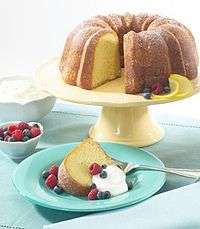Ciambella
Ciambella (Italian pronunciation: [tʃamˈbɛlla]; plural, ciambelle) is an Italian ring-shaped cake with regional varieties in ingredients and preparation. As an example, a basic version of the cake could be prepared using flour, baking powder, salt, eggs, milk (or cream), sugar, oil and vanilla flavoring. Honey is sometimes added as a sweetener. To create the light texture the sugar and eggs are whisked together, and oil and milk are added while whisking continuously until the mixture is frothy. Then sifted baking powder and flour are added to the dry ingredients and the cake is baked in a ring shaped pan.

Some versions of ciambella can also be made with kamut flour. Butter may be used instead of oil, and mixed berry yogurt (yogurt ai frutti di bosco) can be added to the batter. Common flavorings include lemon, orange, chocolate or cocoa, hazelnuts and vanilla. The finished cake may be decorated with powdered sugar, pine nuts, toasted almond pieces, apricot jelly or pistachios.[1]
Regional
Many regions have registered one or more types of ciambella in their official list of traditional food products, including:
- Calabria
- cuddrurieddru, a sweet fried doughnut made with flour and boiled potatoes, typically made at Christmas.
- Campania
- graffa, a sweet fried doughnut made with flour and potatoes, covered with caster sugar, often best when eaten just out of the frier, very soft.
- Emilia-Romagna
- Lazio
- ciambella a cancello, 'gate doughnut' with an intricate rosette shape, made using aniseed and local wine.
- ciambella all'acqua, 'water doughnut', so-called because it is first boiled in water and then baked.
- ciambella ellenese, a small, knot-shaped doughnut made with cinnamon and covered with rose water.
- Marche
- ciambella frastagliata, 'jagged doughnut', made with mistrà (aniseed-flavour liquor) and a high proportion of egg, which is boiled, dried with a cloth, cut in half and baked until crispy.
References
- Peli, Daniela; Ferrari, Francesca (2014). Dolci per la Colazione. ISBN 9788888072425.